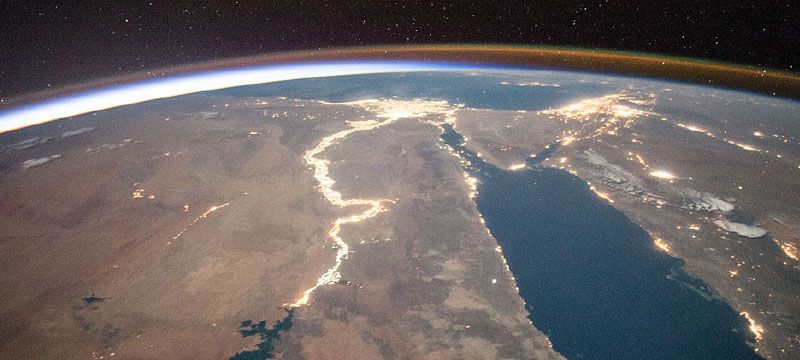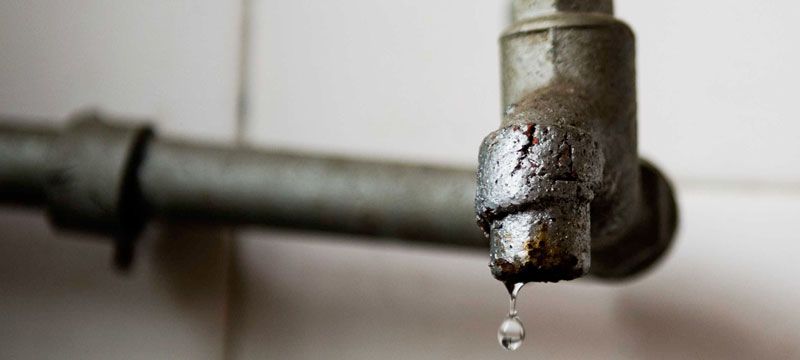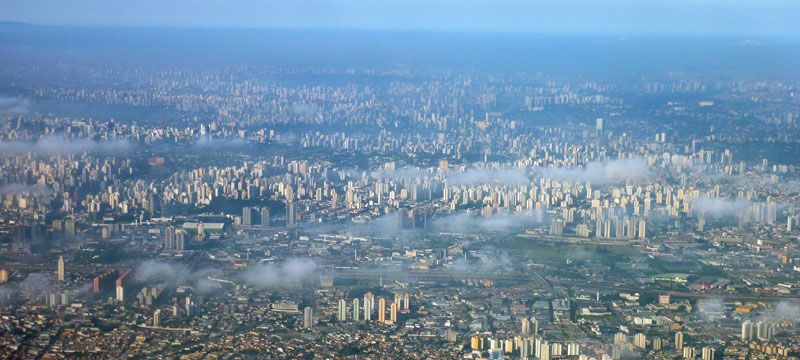Planning with Water
Published on by Peter Neill, Founder and Director at World Ocean Observatory in Academic
Building a new value premise and societal change around water as the most valuable commodity on earth. What's the plan?

DAVOS AND THE WORLD ECONOMIC FORUM
The most important global risk faced to day is the world water crisis. “The world is not doing enough,” a 2012 World Economic survey reports. “Though the problems of floods, drought, and inadequate water supply that were projected more than two decades ago have come true, little is being done to address them effectively.
Leaders are especially ill-prepared for widespread social instability…” Circle of Blue quotes Bob Sanford, chair of the Canadian Partnership Initiative, as follows: “We didn’t realize until recently how much our economy and society relied on hydrologic stability.”
Well, that is not entirely true. China, for example, has been building massive water transfer systems to move water from areas in the south to the more arid north where drought, industrial irrigation, and flagrant pollution have brought scarcity as well as economic and political crises. A recent analysis by researchers at the Leeds Water Research Institute at the University of East Anglia in the UK, published in the Proceedings of the National Academy of Sciences, suggests that this extraordinary expenditure of public funds and labor may not be sufficient to meet increased economic and population growth.
Dabo Guan, Professor of Climate Change Economics at the University’s School of International Development, is quoted by Bloomberg News describing the system as “pouring good water after bad.”
China, India, Australia, and the United States: all are grappling with these immediate, devastating, and disruptive conditions. The rising price for grain and rice resulting from severe drought has been suggested as a major contributor to social unrest, perhaps toppling a government in Egypt and crippling a regional economy in Australia and escalating prices in food dependent markets throughout the southern hemisphere. These are not problems easily dismissed or ignored. We are fighting wars for water, as much as for oil or religion.
The old solutions do not serve these extreme events. It may be that the old engineering ideas and designs like the Tennessee Valley Authority in the U.S. or the diversion of northern rivers in India cannot meet the challenge of exponential demand, degraded supply, and global warming.
There is a direct link between water abundance and human well being, between adequate supply and the sustainability of any community, rich or poor. Northern California is a verdant region in the U.S., dependent on its primary watershed, the Sierra Nevadas, and distributed by engineered solutions. Water rationing, inadequate supply at key points in growth of fruit and crops, and weak and declining harvests can bring even such a community to its knees. The response cannot be conventional, cannot be more of the same. The time for that has passed.
“We didn’t realize until recently how much our economy and society relied on hydrologic stability,” the Davos report states. Perhaps we do now, and if finally so, what are we going to do about it?

image credit: Charity:Water
THE MOST VALUABLE COMMODITY ON EARTH
If global leaders at the World Economic Forum have realized how much our economy and society rely on hydrologic stability, what do they intend to do about it? Despite the drought and water scarcity, despite the ongoing pollution of existing water supply by fertilizer, chemicals, toxic spills, and all the rest, what action do you suppose might be taken by this leadership to address this evident, recurring, apparently critical need?
In the United States Congress, the response is to deny climate change as a cause of such instability and to work with fervor and dedication to dilute the protections of the Clean Water Act, to weaken if not eradicate the Environmental Protection Agency, and otherwise to relieve any restrictions or prohibitions for any activity that will simply make the matter worse. It represents the most perverse intersection of short-term profit for a politically motivated interest and long term loss for everyone else; so it goes, at least until the price of oil collapses and all the numbers, justifications, and reasons for sustaining the status quo go down with a great sucking sound heard painfully from Houston to Anchorage to New York, from Moscow to Beijing.
There is of course no alternative plan. Or is there?
The most valuable commodity in the world is no longer oil. All the calculations change, even as the energy companies and their investors double down on what surely they hope will be a return to the good old days. Communities suffering from the consequences of fracking or exploding pipelines find leverage to fight back against what has been so cleverly packaged as beyond them and essential to the national interest.
What then is the most valuable commodity on earth around which a new, more viable, more realistic system of value can be built? It is water, the one natural product that every person, rich or poor, from anywhere around the globe, must rely on for life. The collapse of oil, then, could be seen as a unique opportunity to shift our value system to an alternative based on water, priced by its utilitarian necessities.
Of course we need energy to grow, not just for growth’s sake but to meet the known requirements of a world population that is increasing dramatically by the millions from year to year. If we cannot provide basic living for these, in the form of health, shelter, food, and employment, not to mention the continuity of the quality of life that we enjoy, then we should be prepared to accept our responsibility for the unfortunate consequences. It does not take much imagination to envision the outcomes; we see them in the disruptive conditions of poverty, political volatility, and social injustice in those places and among those peoples already deprived of what we take for granted.
If the World Economic Forum leaders came to an understanding of hydrologic stability as an evident, valid requirement for the future, then indeed the time is now for the alternative plan that addresses the what and how such a system can be built from the ashes of coal and dirty oil and their lingering consequences that have proven so antagonistic and detrimental to communities worldwide.
Is it possible to construct a new system on the true value of water? What decisions must be made? Do we need new technologies and more money, or can we actually change by using the technologies already in hand and re-allocating existing assets? Can we finance such a change with funds divested from the extraction industry and re-invested in alternatives? Can we move the oil subsidies away from a dying industry to bring the new alternatives to scale? Can we take back the definition of our future from those who see it only as a replication of our past? Can we make, and execute, a new plan?
Of course we can. It is, in fact, already in progress, perhaps not so publicly known, perhaps not so clearly understood, but there are amazing examples of a kind of progress based not on resiliency to post-traumatic duress but on a sharpening vision of the future. What can it be? It is a world built around the movements and cycles of water, and the ocean sits at its center.

image credit: Nile River in Africa. Night observation taken by NASA astronaut Scott Kelly. July 27, 2015.
NILE RIVER BASIN AND THE DANISH HYDRAULIC INSTITUTE
What I am suggesting here is an alternative to coal, oil, and gas as a standard around which we calculate value and organize our communities, economies, and international relationships. It may seem a drastic idea, but if you take some time to think it through, you may discover a compelling logic, a recalculation of value, a strategy for action toward a realizable future using existing technology and re-allocated financial assets.
How would it work? Let me give you an example of a planning initiative that speaks to the why and how. The Nile River Basin comprises 3 million square kilometers along a 6,695 kilometer course starting at the headwater in Rwanda and Burundi, support millions in ten riparian nations along the watershed, and descending to Egypt and the Mediterranean Sea. The river’s erratic flow, and the associated activities supported by that flow, has been severely impacted by climate change factors – temperature rise, persistent droughts, extreme weather, flooding, and the inevitable social-economic consequence in terms of energy and food production, health and sanitation, employment, poverty, and regional security.
The UN Environment Programme (UNEP), in cooperation with the Nile Basin Initiative, with support by the Swedish International Development Agency, retained the Danish Hydraulic Institute (DHI), to gather all available data regarding all activities and needs throughout the watershed, to generate from that data a complex hydraulic model through which to model climate change projected effects, growing demand, and multiple requirements for water resources throughout the entire basin over time.
The DHI is a non-profit consulting firm chartered by the Danish Government that has developed proprietary software capacity that can assimilate massive amounts of data and make it adaptable for testing impacts of projected future conditions and scenarios. It is an astonishing planning tool. The Nile model includes rainfall, runoff, lakes, reservoirs, dams, wetlands, and irrigation water demands. The projections applied cover two thirty-year periods: from 2020 to 2049 and from 2079 to 2099. Comparing the changing capacity with population growth, rural and urban shifts, agricultural and manufacturing needs revealed not just what amount of water might be available, but also how what is available can be efficiently and effectively managed. From this information, very specifically located in a place, a region, a settlement, or a nation, decision-makers were provided with informed conditions on which they could evaluate and place water dependent uses, target limited financial resources, and understand the management practices and professions for which to train personnel to operate the system in the future.
Take a moment to think about the implications of this, not only for the Nile River, but also for all the other multi-state and transnational watersheds around the world that could benefit from a similar understanding of the hydraulic reality on which their future viability will depend. For such a system to work requires local knowledge, communication, cooperation, implementation, evaluation, and further planning and action – all bringing together managers from nations sometimes antagonistic over other issues, but understanding that without such an agreement and collaborative action, the absence of adequate water supply at any point along the line will lead to deprivation and unrest.
Apply this methodology to any waterway you know and you immediately see how decisions made upstream or down, indifferent to conditions downstream or up, are the instigators of competition and conflict that most often does not serve anyone well.
The Nile Initiative is just one compelling example of planning with water. If nations can find consensus and compromise around water as an egalitarian human right, what else might they find possible through this first success? What other agreement might be found through the understanding and experience derived from one system that unites us all?

NON-REVENUE WATER
Hydraulic engineers speak of “non-revenue water,” that which is produced by collection but cannot be valued because of the utility lost to leakage and other forms of waste. If you think about your own water usage, you can begin to understand what I mean. Whether or not you draw your water from a well or a municipal system, picture in your mind how that water flows through your home, what it provides, and where might be the places or behaviors where the value of that water is lost. Showers, toilet flushes, food preparation, car washes, lawn and garden irrigation—these represent the major functions of water in the home. For how long do you or your children shower? How many times a day do you flush the toilets? Do you leave the water on when you brush your teeth or wash your dishes? These are all typical points where each of us loses the value of water down the drain, rarely recycled, mostly wasted.
If you take this one phenomenon, add to it theft of water or inaccurate metering, or free use for fire fighting and other civic necessities, the Danish Hydraulic Institute totals for US$14 billion annually lost by water users, managers, and utilities due to non-revenue water.
To understand water use, the DHI conducts water audits, identifying and analyzing the various stages along the distribution chain. The process examines water supplies, owned and imported, to calculate total systems input. Against this is measured water supplied and exported, consumption authorized and unauthorized, billed and un-billed consumption, apparent and real losses to construct a balance sheet that reveals revenue water minus non-revenue water showing either surplus or deficit derived from the existing system.
These analyses can reveal weaknesses and inefficiencies along the way, and can also reveal strategies for repair, modification, and increased economies to make the system better. Localized pressure tests and flow meters can point to very specific, reparable problems, reduce leaks and blowouts, and also reduce maintenance costs and failure rates, diverting funds to upgrades and replacements. Similar tests can discover areas of deteriorated pipe, broken connections, malfunctioning valves and pumps, and failed or tampered meters. In its entirety, the water audit gives a real-time picture of a system that may have been constructed decades previous, sporadically maintained or improved, and in need of a major overhaul or modernization. Finally, this information can provide the data required to make management and financial decisions, accurately predict and allocate budgets over time, and provide a schematic for capital improvement, investment in new technologies, a model for a better system with far greater efficiency and return, and dramatically reduced waste of the most valuable commodity on earth. All this from a reasonable evaluation of usage in the home or along the path of distribution.
Earlier I described a much larger audit of the 3 million square kilometer area of the Nile River basin. Beyond scale, what is the difference between that endeavor and what we might do at home, a key place where a change in behavior correlates to a shift in the data set and resultant improvements? What you do each day with your water is part of an enormous hydraulic reality by which precious water moves through a global natural, financial, and political system of distribution and re-distribution, through cycles and conveyors and upwellings that too often corrupt or poison the water consumed. Removing any water from that system, even a single drop, denigrates it and denies it for the future.
If we can understand the peculiarities of our plumbing and habits at home, then we can fix them. The same holds true for a municipal water system. And the same holds true for a watershed. And the same holds true for the ocean, the greatest water system on earth. If we can understand how our patterns of water use and waste are connected, perhaps we can look to solutions evident and possible through planning with water.

WATER CRISIS IN SÃO PAOLO
What does it mean when we don’t plan with water? As we have discussed, unlimited consumption, pollution, outdated treatment and distribution systems are evident in most cities and nations where population growth has created an ever-increasing demand. When you examine these specifics, you find that water management has been ever problematic, taken for granted, an essential resource otherwise left un-conserved and unprotected against any change in use, demand, or circumstance.
Let’s take a look at the city of São Paulo, the largest and richest metropolis in Brazil, some 20 million inhabitants located in a country of glaciers, mountains, the Amazon River watershed, and a collection of large dams designed to exploit to the maximum what seemed to be inexhaustible water. Brazil, the “Saudi Arabia of water” as repeatedly described in press and financial reports.
But today the press describes a very different picture. In a February 16, 2016 article in the New York Times, São Paulo is described as “a dystopian situation” where the city water pressure is critically diminished, taps are beginning to run dry, rationing is predicted, basic sanitation and hygiene are threatened, and water anarchy may be the outcome when the available supply is finally exhausted.
How can this have come to pass? First, the vast amount of water available has grown a culture of unlimited consumption and expectation. So much water has nurtured a pattern of indiscriminate use and social and political indifference. The economy of the city, indeed the nation, is based on an assumption of unlimited supply. Earlier we discussed non-revenue water, that which is leaked, stolen, wasted or otherwise not used or paid for as a result of rusted pipes, pumps, and valves, and long-deferred system maintenance or equipment replacement over time. Some of the São Paulo water supply is estimated to be lost to such mismanagement—one third discarded without compensating return!
As city grew to megacity, from slums to industrial areas to commercial towers to suburban homes, the luxury of water was a given. But that same expansion and growth has had its concomitant, contradictory side effects in the form of vast volumes of water required for manufacturing—polluted, deposited in the local rivers, and removed forever from the water cycle. To meet the demand of growing population and need for urban space, wetlands were filled, surrounding areas were cleared and constructed, and reservoirs were left inadequate to store the increase volume required. Deforestation of the rain forest changed the local micro-climate of the region, increasing run-off, erosion, and rainfall patterns. More importantly, the more extreme changes in global warming and weather patterns, rising temperatures, and storms resulted in the larger affect of reduced mountain melt, induced drought, increased the demand for irrigation, and otherwise rapidly constricted the water capacity of the nation and undermined the economy on which the nation depends.
The disruption of the predictable supply of water on the basis of daily need is a certain prelude to social and political unrest.
The politicians and managers postponed or ignored the problem, and one assumes will somehow be held accountable. But that is not good enough. The crisis, long in the making, will also be long in its solution. It will require time, immediate action, leadership, community engagement, and major investment of public funds. And São Paulo is not the only city where similar conditions exist, an incipient crisis evident as a predictable result of climate change, lack of foresight, indifferent management, irresponsible policy, failed investment in alternative systems and behaviors, and political cowardice.
What will it take to meet the challenges of our global environmental disconnection and natural resource abuse? Will we wait until it’s too late, for the loss of what nature provides, for the crisis in health and welfare, for war and anarchy to make it better?
Our last chance for water is the ocean. What’s the plan?

image credit:: DHI
OLOMOUC: A SMALL CITY WITH A BIG PLAN
Let me give you another, more positive example to São Paulo’s water crisis: the city of Olomouc, capital of Moravia on the Morava River, in the east of the Czech Republic. While dramatically smaller than São Paulo, with a regional population of 500,000 to São Paolo’s 20 million, the city nonetheless evinces a comparable catalogue of critical symptoms: an old and outmoded water network, growing population, area expansion, urban renewal and reconstruction, public demand and expectation of service, and impact of the consequence of climate change, in localized but inevitable effect, on past weather patterns, industry and agriculture, and social behavior. What to do?
To its credit, the municipal government commissioned the Danish Hydraulic Institute to do a complete analysis of the overall water system and its management plan to include its current demand and future needs to integrate and redevelop regional collection and distribution, connect elements such as the sewer network, storm water drainage, and watershed culverts and creeks, and provide a process for design and cost estimation of recommendations derived.
Commissioned in 2012, the consultants produced a plan through the year 2030 by first mapping the regional drainage area; second, creating computer analyses and models to evaluate and simulate present and future conditions; and third, making recommendations for a reconstruction plan that prioritized the necessity of repairs and assessing the technical and financial aspects of future developments.
DHI describes the scope of work as follows: evaluation of network conditions; solving existing variations in water supply pressure; examining combined sewer overflows and interrelation with flow protection measures; identification of flood risk zones; integration of infrastructure improvements in city investment plan; calibration of sewer and water supply models; analyzing and updating existing sewer and water supply systems; and setting guidelines and conditions for new municipal construction. In effect, using the most sophisticated mapping, data management, and modeling software, the consultants could provide a single comprehensive visualization of integrated existing conditions, indicate weakness and priority for repair and maintenance, model impact of changing future conditions, suggest resultant infrastructure improvements, and estimate costs for municipal investment over a twenty year period.
Suddenly, unlike São Paulo, Olomouc had a plan. The challenge, of course, will be to finance it, adapt it, and apply it to the inevitable changing conditions the future will bring. The politics and the costs will be real and difficult, but the plan at least provides a responsible structure for a responsible governmental response to the need of the community to manage its most important socio-economic resource.
Why do I belabor this example of a small inland city? Like São Paulo and many other cities around the world, Olomouc sits on a river somewhere in between the mountains and the sea. These habitations are both reality and symbol of the water connections and cycles on which we have and must depend. This water sustains the agriculture, industry, health, and myriad other social benefits of each place along the way, from upstream to downstream to the ocean and back again. The water provides, the watershed distributes, the ocean collects and circulates, and the cycle turns like history, like fate, like the circle of civilization.
- - -
Planning with Water is an excerpt from The Once and Future Ocean: Notes Toward a New Hydraulic Society published in April 2016.
Media
Taxonomy
- Policy
- Technology
- Environment
- Water Resources
- Governance & Planning
- Water
- Conservation